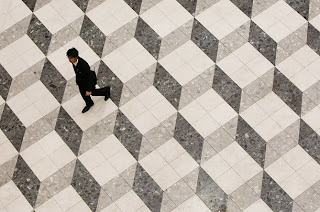Questions
- Double click on "server_drives". Then go to my computer, double click on "jstudents on 'akinspubserver', Click into the PhotoJournalism, Then click on your class period, Then your name.
- We use Blogger.com to post our assignments on a blog.
- You'll need an circular oatmeal can. First cover the inside of the oatmeal container and lid with black construction paper and tape. Be sure to cover it completely. Then cut a square (the size of your thumb) on the side of the container. Cover the hole with foil in the inside of the can. Take a small needle and make one tiny whole in the foil. Then make a flap the would cover the foil on the outside on the can with black construction paper.
- The pinhole forces every point emitting light in the scene to form a small point on the film, so the image is crisp. The film records the image that comes in through the pinhole. The camera records a nice, in-focus image of the scene that you point the camera at.
- Rule of Thirds - If you imagine that your image is divided into 9 equally divided squares. Try to position your subject where the lines of the squares intersect.
- Balancing Elements - When placing your subject in the rule of thirds you should try to balance the weight position another object of lesser importance on the opposite side to feel the empty space
- Leading Lines - When following this rule you should try to create a line or lines that leads up to the subject. There are many different types of line you can do such as: straight, diagonals, zig-zag, and etc.
- Symmetry and Patterns - When both sides of your photo involve the same components the a parallel to each other.
- View Point - Rather than just shooting from eye level, consider photographing from high above, down at ground level, from the side, from the back, from a long way away, from very close up, and etc.
- Background/Simplicity - When taking a picture try to take the picture with the subject in front of a plain background.
- Create Depth - Try making your picture look 3-D. Try imagining that you can walk into your picture.
- Framing - When taking a photo try to frame the subject between something
- Cropping - Cut out all unnecessary details to keep the viewer's attention focused on the subject
- Mergers and Avoiding Them - Make sure they is nothing going out of your subject.
- When putting action and emotion into a photo you making the photo look like its telling a story.
- By putting action and emotion in a photo the viewer can see whats happening in the photo.
- Multimedia is usually a video or a video of photo/slide of photos. We used multimedia when trying to see how multimedia is stronger than just looking at a photo.
- First sentence: Subject -- action verb (present tense) -- object -- how -- why -- when -- where.
- Second sentence: Subject -- verb (past tense) -- object (describes background [context] of the situation shown in picture.)
- Strong action verbs can explain to the viewer what is actually happening in the photo.
- Ethics come into play when the photographer alters the photo. Fashion photography is very unethical because they alter a person a person to make it look better but, they are deceiving people when they do that.
12. Explain the difference between a portrait and a self portrait.
- Portrait is when you take a picture of someone else. A self portrait is when you take a picture of yourself.
13. Explain what characteristics of a good portrait are.
- The picture tells a story. There are great emotions and actions in the photo. And also following all the rules of compostion.
14. Explain what the major differences are between newspaper and yearbook.
- Newspaper has more to do with getting information to the school about current events.And involves more writing. Yearbook gives you information about different clubs, groups, and activities that have happend during the entire school year. Its involves more photos.
Defenitions
Aperture
- limits the amount of light passing through lens or into a mirror.
Shutter
- allows light to pass through for a period of time.
Exposure
- the total amount of light on a photo.
F-stop
- ''focal length''
Single lens reflex
- form of reflex camera in which the reflecting mirror retracts when the shutter is released.
Negative
- photographic image that reproduces the bright portions of the photographed subject as dark and the dark parts as light areas
Positive
- denoting a print of tranperancy showing the brightness values.
Contact sheet
- all frames of a developed roll of negative print film.
Agitation
- helps speed up development.
Stop bath
- an acidic neutralizer to slow the effects of the developer.
Fixer
- remove remaining light sensitive halides by converting them into soluable salts.
Safe light
- transmit the maximum amount of light that can be used safely.
Burning
- using additional light exposure during film development in order to darken selected areas of a photo.
Dodging
- blocking a portion of the light when printing a photograph so that an area of the print lighter.


































